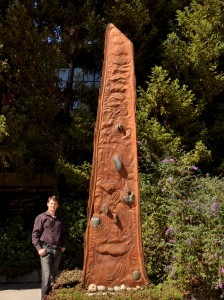
Title: Living Waterway • Medium: Redwood& river rocks • Dimensions: 15’ tall X 3’ wide X 2’ deep • Piece and Photo By: Vincent King
Surrounded by living redwoods at the Riverfront Plaza courtyard at 200 P St. stands a massive 15-foot sculpture made by East Sacramento artist Vince King. A redwood slab infused with river rock, this piece by King is carved to look like a vertically flowing river complete with wood peeling around river rocks embedded into the tree.
King said he has done this to represent the idea of evapotranspiration, which is the method by which trees and other plants pull water from the ground through their root system and eventually release it back into the atmosphere.
While his work was installed on Thursday, Aug. 15, its unveiling was held on Sept. Oct. 12 at the third annual ‘Art on the Plaza’ with music by Proxy Moon and art by Sacramentans, including: Vicki Asp, Donna Billick, John Collentine, Phill Evans, Marc Foster, Christopher Frisz, Taylor Gutermute, Frankie Hansbearry, Susan Hoehn, Maureen Hood, Wes Horn, Imi Lehmbrock-Hirschinger, Rhettt Neal, Juanishi Orosco, Alan Osborne, Chuch Sullivan, Roy Tatman, Shephanie Taylor, and Maria Winkler.
A former planner for Sacramento County for environmental issues, King said he has always sidelined the thought of being an artist. During the economic downturn, local government budgets had been hit hard and Sacramento County was among the worst. Layoffs had begun and, as a relative newcomer in a last in first out hiring system, King said it was a matter of time until he was the next in line.
“In February 2011, my life as an artist began. Compared with the sometimes glacial speed of long-term city planning, I now enjoy seeing daily progress on my creations, the complexity of which is not constrained by limited time,” he said.
He remembers when this thinking began to change. In October 2010, he was nearing completion of the piece titled Window to the Soul, which he simply refers to as “The Eye.”
He had worked on this piece off and on with hand tools while working full time for six years. “It was always my magnum opus. I completed many small pieces, wooden gifts for friends mostly, but ‘The Eye’ seemed everlasting, until then,” he said. “I was actually nearly done after countless hours of work and 500-plus razor blades. Done, but better than done, it is good. My mind was finally free to think of new possibilities. I had held it back for six years, but now it was free. What else could I make? But there was a problem.”
He knew he wanted to do bigger, more complicated work, but working off and on with marble is nearly impossible. Each move is final and each piece takes a lot of time.
“If you have not worked on a piece for a week or month or six months, it takes more time to remember where you were and what you must do. Clearly, I needed more time to work without interruption to do bigger pieces. Luckily, I was about to get all the time I wanted,” King recalled.
Aesthetically, King enjoys variety and complexity. King varies the size of his sculptures from a few ounces (such as a nose carved into a chip of marble) to hundreds of pounds (like a 3-foot diameter globe he named “Pangea”). He also combines the mediums of stone, wood, and occasionally metal such as in his piece called, “You are what was,” which is a marble leaf suspended from a wood and steel frame. Finally, he combines sculptural styles from realism to abstraction to cubism. For example, the piece, “The Embraced,” depicts a curvy woman carved in marble adjacent to a cubic man made from wood. Similarly, the piece, “(AUG) start,” at first glance may just look like an abstract twist of delicately carved marble, but it is also a twisting double helix representing the start codon in a genetic sequence.
His ideas stem from his educational and work backgrounds, documentaries, as well as concepts he’s learned while listening to books, podcasts, and the radio while he works. “One of the biggest perks of working as a sculptor is that I can simultaneously listen to audio books and podcasts all day. I enjoy most everything non-fiction from biographies and political commentary, to outdoor adventures and detailed recounting of the financial collapse or other historical periods.
“So, not only do I have a lot more time to sculpt, I am also exposed to exponentially more information that I can feed into my work. I also read the paper and am a constantly pondering current events or some of the questions we humans seem to ask ourselves through religion and science. I cannot deny that I am also drawn towards the natural beauty of the outdoor world, which I attempt to reflect in my work. I like to take all these things and translate them to stone or wood in ways that one may not otherwise expect or previously seen.”
